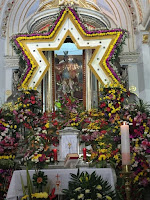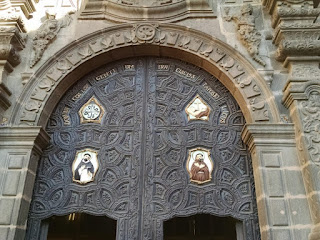We were up for an early breakfast
and departure on the bus by 07:30, headed out of Mexico City entirely toward
San Miguel del Milagro, about two hours to the east in the state of Tlaxcala.
We could feel our ears popping as we left the huge bowl in the midst of the
mountains in which is Mexico City – I think Roberto might have said at one
point that we topped out at about 10,000 feet above sea level. And that was
going through a pass between Monte
Tlaloc to the north and two mountains to our south that had all our attention.
 It was a beautiful, albeit hazy, day, perfect for viewing Popocatepetl (“The
Smoking Mountain”) and Iztaccihuatl (“The White Woman,” also called La Mujer Dormida, “The Sleeping Woman,”
because from a certain aspect it looks like a sleeping woman). Both of the
mountains, respectively the second and third highest in Mexico, are volcanoes;
Iztaccihuatl is dormant, but Popocatepetl is very active. We slowly rounded
them to the north, and were graced with seeing Popocatepetl belch out several
clouds of steam.
It was a beautiful, albeit hazy, day, perfect for viewing Popocatepetl (“The
Smoking Mountain”) and Iztaccihuatl (“The White Woman,” also called La Mujer Dormida, “The Sleeping Woman,”
because from a certain aspect it looks like a sleeping woman). Both of the
mountains, respectively the second and third highest in Mexico, are volcanoes;
Iztaccihuatl is dormant, but Popocatepetl is very active. We slowly rounded
them to the north, and were graced with seeing Popocatepetl belch out several
clouds of steam.
 We stopped partway along the journey for a pit stop and
extended view of the sight – and photos – then continued on to San Miguel.
During the drive, Roberto told us the history of the Mexican Wars of
Independence in the 19th century, Pablo related the story of the
mountains [LINK], then
Roberto took back up with the story of the apparition of St. Michael the
Archangel in 1631 – one hundred years after Our Lady of Guadalupe – to an
Indian peasant named Diego Lazaro [LINK], raising him from the
dead and revealing a miraculous healing well, hallowing the place now known as
“St. Michael of the Miracle.”
We stopped partway along the journey for a pit stop and
extended view of the sight – and photos – then continued on to San Miguel.
During the drive, Roberto told us the history of the Mexican Wars of
Independence in the 19th century, Pablo related the story of the
mountains [LINK], then
Roberto took back up with the story of the apparition of St. Michael the
Archangel in 1631 – one hundred years after Our Lady of Guadalupe – to an
Indian peasant named Diego Lazaro [LINK], raising him from the
dead and revealing a miraculous healing well, hallowing the place now known as
“St. Michael of the Miracle.”
 We spent a couple of hours there,
passing through an open-air market, witnessing the colorful enthusiasm of
Mexican piety, including a custom, this Sunday after the Feast of the
Presentation (02 February), in which they brought dolls of the Infant Jesus to
church to be blessed. Sunday Mass was in progress as we passed the main church
– there was no getting in, but we went into a chapel at the adjacent Shrine of
San Miguel del Milagro, where Fr. Peter said Mass and then we were able to have
bottles filled with healing waters from the well. The well, just outside the
main church, is now just about dry, so the brothers who staff the shrine allocate
it to pilgrims, distributing holy water with a dash of water from the holy
well.
We spent a couple of hours there,
passing through an open-air market, witnessing the colorful enthusiasm of
Mexican piety, including a custom, this Sunday after the Feast of the
Presentation (02 February), in which they brought dolls of the Infant Jesus to
church to be blessed. Sunday Mass was in progress as we passed the main church
– there was no getting in, but we went into a chapel at the adjacent Shrine of
San Miguel del Milagro, where Fr. Peter said Mass and then we were able to have
bottles filled with healing waters from the well. The well, just outside the
main church, is now just about dry, so the brothers who staff the shrine allocate
it to pilgrims, distributing holy water with a dash of water from the holy
well.
 It was a beautiful, albeit hazy, day, perfect for viewing Popocatepetl (“The
Smoking Mountain”) and Iztaccihuatl (“The White Woman,” also called La Mujer Dormida, “The Sleeping Woman,”
because from a certain aspect it looks like a sleeping woman). Both of the
mountains, respectively the second and third highest in Mexico, are volcanoes;
Iztaccihuatl is dormant, but Popocatepetl is very active. We slowly rounded
them to the north, and were graced with seeing Popocatepetl belch out several
clouds of steam.
It was a beautiful, albeit hazy, day, perfect for viewing Popocatepetl (“The
Smoking Mountain”) and Iztaccihuatl (“The White Woman,” also called La Mujer Dormida, “The Sleeping Woman,”
because from a certain aspect it looks like a sleeping woman). Both of the
mountains, respectively the second and third highest in Mexico, are volcanoes;
Iztaccihuatl is dormant, but Popocatepetl is very active. We slowly rounded
them to the north, and were graced with seeing Popocatepetl belch out several
clouds of steam.  We stopped partway along the journey for a pit stop and
extended view of the sight – and photos – then continued on to San Miguel.
During the drive, Roberto told us the history of the Mexican Wars of
Independence in the 19th century, Pablo related the story of the
mountains [LINK], then
Roberto took back up with the story of the apparition of St. Michael the
Archangel in 1631 – one hundred years after Our Lady of Guadalupe – to an
Indian peasant named Diego Lazaro [LINK], raising him from the
dead and revealing a miraculous healing well, hallowing the place now known as
“St. Michael of the Miracle.”
We stopped partway along the journey for a pit stop and
extended view of the sight – and photos – then continued on to San Miguel.
During the drive, Roberto told us the history of the Mexican Wars of
Independence in the 19th century, Pablo related the story of the
mountains [LINK], then
Roberto took back up with the story of the apparition of St. Michael the
Archangel in 1631 – one hundred years after Our Lady of Guadalupe – to an
Indian peasant named Diego Lazaro [LINK], raising him from the
dead and revealing a miraculous healing well, hallowing the place now known as
“St. Michael of the Miracle.” We spent a couple of hours there,
passing through an open-air market, witnessing the colorful enthusiasm of
Mexican piety, including a custom, this Sunday after the Feast of the
Presentation (02 February), in which they brought dolls of the Infant Jesus to
church to be blessed. Sunday Mass was in progress as we passed the main church
– there was no getting in, but we went into a chapel at the adjacent Shrine of
San Miguel del Milagro, where Fr. Peter said Mass and then we were able to have
bottles filled with healing waters from the well. The well, just outside the
main church, is now just about dry, so the brothers who staff the shrine allocate
it to pilgrims, distributing holy water with a dash of water from the holy
well.
We spent a couple of hours there,
passing through an open-air market, witnessing the colorful enthusiasm of
Mexican piety, including a custom, this Sunday after the Feast of the
Presentation (02 February), in which they brought dolls of the Infant Jesus to
church to be blessed. Sunday Mass was in progress as we passed the main church
– there was no getting in, but we went into a chapel at the adjacent Shrine of
San Miguel del Milagro, where Fr. Peter said Mass and then we were able to have
bottles filled with healing waters from the well. The well, just outside the
main church, is now just about dry, so the brothers who staff the shrine allocate
it to pilgrims, distributing holy water with a dash of water from the holy
well.
Finally, on the long ride back to Mexico City and the Galleria Plaza, after Evening Prayer we were treated to a movie – For Greater Glory, starring Andy Garcia, the story of the 1920s Cristiada War in Mexico. Actually, Anne and I had seen and enjoyed this 2012 film only a couple of weeks ago, in our preparation for this trip since I knew that conflict provided the context for Padre Pro’s martyrdom, but we enjoyed seeing it again. Briefly, set mainly in the west of Mexico, it told the story of an atheist general hired by the Cristeros, faithful Catholics taking up arms in resistance to the persecution initiated by President Plutarco Calles, to bring military discipline and leadership to their cause. Through the conflict and the witness of a young boy who runs away from home to join the war, the general finds his own faith just before he too falls in an ambush by the Federales. But we ended up on a cliffhanger ending – when we arrived at the hotel, we had just witnessed the martyrdom of the boy, Jose Sanchez, who refused to forsake his God, even in the face of horrific tortures. (We would, of course, finish out the movie, about another twenty minutes, the next evening.) Roberto then said that Jose was to be canonized during Pope Francis’ upcoming visit to Mexico (which is not actually true – his required third miracle was just recently authenticated and he will be canonized, but the date has not been set [LINK]). But our group gained another rallying cry –to Taylor’s “Ave Maria!” (and “Bueno Bueno Bueno!” which began as Roberto’s mic' check) which we had from the beginning, now there was added the Cristeros’ “Viva Cristo Rey!,” “Long Live Christ the King!”





























































































































No comments:
Post a Comment